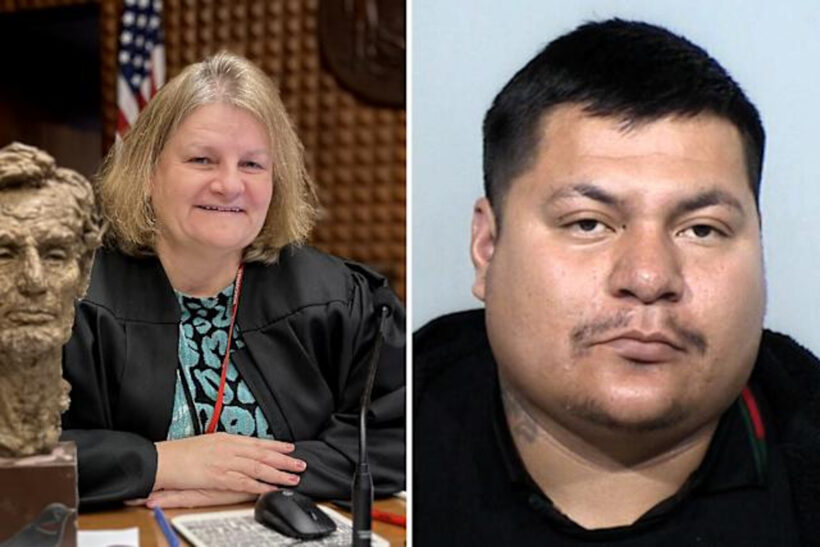
Judge Hannah Dugan (left), Eduardo Flores-Ruiz (right)
redo Jump to...
print Print...
NOTE:
- ICE identified Eduardo Flores-Ruiz as an illegal immigrant from Mexico who had already been issued an I-860 Notice and Order of Expedited Removal by U.S. Border Patrol Agents on January 16, 2013, and that Flores-Ruiz was “removed to Mexico through the Nogales, Arizona, port of entry.”
- Once you have an order of expedited removal, you can be deported without a court hearing, because you have been determined inadmissible to the United States.
- Any argument that Flores-Ruiz had a right to stay in the country is moot; under the Obama administration the U.S. government determined that he could not be admitted under any circumstances.
(by Emily Crane and Samuel Chamberlain, NY Post) – A veteran Wisconsin judge was arrested Friday on charges of helping a Mexican illegal migrant evade Immigration and Customs Enforcement agents in her courtroom.
Judge Hannah Dugan, who has been on the Milwaukee County bench for nearly a decade, is accused of obstruction of justice and concealing Eduardo Flores-Ruiz from arrest following a pre-trial hearing last week.
Dugan appeared briefly in Milwaukee federal court Friday morning before being released after prosecutors said they would not ask for her detention before trial. Her arraignment has been set for May 15.
She faces a maximum of 10 years in prison if convicted on both counts. It was not immediately clear whether Dugan would be placed on leave during her case.
“Judge Dugan wholeheartedly regrets and protests her arrest. It was not made in the interest of public safety,” her attorney, Craig Mastantuono, said during the proceeding.
According to a criminal complaint obtained by The Post, an ICE officer and a US Customs and Border Protection (CBP) official showed up outside Dugan’s courtroom April 18 with a warrant for Flores-Ruiz’s arrest for illegally entering the US, but were told by a security guard and a sheriff’s sergeant to wait outside until after the hearing.
The complaint noted that Flores-Ruiz, 30, had been deported from the US once before in 2013. It was not immediately clear when he crossed the border again, and there is no evidence he did so legally.
Flores-Ruiz was appearing before Dugan April 18 for a pre-trial conference on three misdemeanor battery charges…[On March 18, Flores-Ruiz was charged in Milwaukee County Circuit Court with three counts of battery, domestic abuse, and infliction of physical pain or injury. “Flores-Ruiz was accused of playing music too loudly in the home. The complaint alleges Flores-Ruiz punched another person 30 times, then struck a woman who tried to break up the melee.” Both victims needed to go to the hospital].
The complaint states that while the team assigned to arrest Flores-Ruiz, which included FBI and DEA agents, waited for the hearing to conclude, they were photographed by a public defender, who informed Dugan’s clerk that “there appeared to be ICE agents in the hallway.”
After speaking with the clerk, Dugan “became visibly angry” and left the bench to confront the federal agents, according to an affidavit by a FBI special agent.
“Witnesses uniformly reported that Judge Dugan was visibly upset and had a confrontational, angry demeanor,” the statement read.
After initially demanding that the officers leave the building if they were not there for a court appearance, Dugan allegedly directed the federal agents away from her courtroom to Chief Judge Carl Ashley’s office after being shown the immigration warrant for Flores-Ruiz.
After Dugan had gone back inside, the complaint states, a deputy assigned to her courtroom told a member of the federal team that he had not alerted Dugan to their presence and added that the judge was “‘pushing’ Flores-Ruiz’s case through.”
After Flores-Ruiz’s appearance was completed with him watching from the jury box, the affidavit states, the deputy heard Dugan “say something like, ‘Wait, come with me’” before escorting Flores-Ruiz and his attorney out of the courtroom’s “jury door” to a non-public area of the courthouse, where the chief judge had advised the feds that they could not arrest Flores-Ruiz.
“These events were also unusual for two reasons,” the complaint states. “First, the courtroom deputy had previously heard Judge Dugan direct people not to sit in the jury box because it was exclusively for the jury’s use. Second, according to the courtroom deputy, only deputies, juries, court staff, and in-custody defendants being escorted by deputies used the back jury door. Defense attorneys and defendants who were not in custody never used the jury door.”
Later, a prosecuting attorney asked about the status of Flores-Ruiz’s battery case and was told it had been quietly “adjourned.”
“This happened without [the prosecutor’s] knowledge or participation, even though [they were] present in court to handle Flores-Ruiz’s case on behalf of the state, and even though victims were present in the courtroom,” the complaint read.
Flores-Ruiz and his attorney made it out of the courthouse before the suspect was arrested by a FBI and DEA agent following a brief foot chase. [After he was encountered by FBI and DEA agents outside the building, Flores-Ruiz “turned around and sprinted down the street” before he was ultimately apprehended, according to the complaint].
…..
Flores Ruiz had been arrested after police were called to a Milwaukee home for a reported fight March 12. In addition to repeatedly punching a person, the police report says he struck a woman who tried to break up the altercation.
One of the reported victims initially told police that Flores Ruiz was “just a friend that was staying the night.” However, when investigators returned to the home the following day, the victims said he had actually been living there for the past year.
Flores Ruiz is now being held in ICE custody at the Dodge Detention Facility in Juneau, about 50 miles northwest of Milwaukee, records show.
…..
Dugan’s arrest comes one day after a recently retired New Mexico judge and his wife were [arrested] for allegedly sheltering a suspected Tren de Aragua gangbanger at their home.
Ex-Doña Ana County Magistrate Judge Jose “Joel” Cano and his wife, Nancy Cano, were accused of harboring Cristhian Ortega-Lopez in their guesthouse after initially hiring him as a handyman.
Dugan graduated from the University of Wisconsin Law School in 1986 and was elected in 2016 to the county court Branch 31. She also has served in the court’s probate and civil divisions, according to her judicial candidate biography.
Before being elected to public office, Dugan practiced at Legal Action of Wisconsin and the Legal Aid Society.
With Post wires
Published at NYPost .com on April 25. Reprinted here for educational purposes only. May not be reproduced on other websites without permission.
Questions
1. a) What charges have been brought against Milwaukee County circuit Judge Hannah Dugan?
b) If convicted, how much jail time might Judge Dugan receive?
2. a) What charges was Eduardo Flores-Ruiz facing in court when the judge helped him escape? (What did he do?)
b) What is Flores-Ruiz’s immigration status?
3. For what reason were federal agents from ICE and the FBI intending to arrest Flores-Dias after his court appearance?
4. What evidence do agents give in the complaint against the judge that demonstrates probable cause?
5. Describe the events that led to the judge’s arrest.
6. If you were one of Flores-Ruiz’s victims waiting in court all day for his hearing, how would you react to news that the judge had adjourned the case and attempted to help him escape ICE agents?
7. Dugan retained former U.S. Attorney Steven Biskupic to represent her and he said in a statement that the judge will “defend herself vigorously and looks forward to being exonerated.”
“Judge Hannah C. Dugan has committed herself to the rule of law and the principles of due process for her entire career as a lawyer and a judge,” Biskupic said in a statement.
Attorney General Pam Bondi responded to the statement by stating that everyone is entitled to their day in court but reiterated that so are victims of crimes.
“They didn’t get it because she let a criminal defendant walk out a door. She helped them. She obstructed justice,” Bondi said.
a) If an average citizen had attempted to help Flores-Ruiz escape, they would most likely be convicted of a crime.
Do you think the judge should go to jail for trying to help Flores-Ruiz escape? Explain your answer.
b) What do you think of Judge Dugan’s commitment to the rule of law?
CHALLENGE: Read the commentary under “Background” below. Mr. Geraghty argues that the facts make it difficult to exculpate Judge Dugan. Do you agree that her actions, as described, clearly violate the law, or should judges have some discretion to act based on their personal beliefs about justice? Explain your answer.
Background
On March 18, Eduardo Flores-Ruiz was charged in Milwaukee County Circuit Court with three counts of battery, domestic abuse, and infliction of physical pain or injury. “Flores-Ruiz was accused of playing music too loudly in the home. The complaint alleges Flores-Ruiz punched another person 30 times, then struck a woman who tried to break up the melee.”
Immigration and Customs Enforcement identified Flores-Ruiz as an illegal immigrant from Mexico who had already been issued an I-860 Notice and Order of Expedited Removal by U.S. Border Patrol Agents on January 16, 2013, and that Flores-Ruiz was “removed to Mexico through the Nogales, Arizona, port of entry.” Once you have an order of expedited removal, you can be deported without a court hearing, because you have been determined inadmissible to the United States. Any argument that Flores-Ruiz had a right to stay in the country is moot; the U.S. government determined that he could not be admitted under any circumstances back during the Obama administration.
ICE matched the fingerprints on their records with the fingerprint records for Flores-Ruiz’s arrest for domestic battery. While it’s not unheard of to have false positives when matching fingerprints in criminal cases, a 2011 study put the false positive rate at one-tenth of 1 percent. There is no reason to doubt that the Flores-Ruiz in the Milwaukee courtroom was the Flores-Ruiz in the ICE database with an order of expedited removal.
Members of ICE’s “Enforcement and Removal Operations Task Force” traveled to the courthouse, with Flores-Ruiz’s arrest warrant in hand, intending to arrest him.
As FBI special agent Lindsay Schloemer laid out in the criminal complaint:
Law enforcement routinely executes warrants and makes arrests in the public areas of buildings such as the Milwaukee County Courthouse. The reasons for this include not only the fact that law enforcement knows the location at which the wanted individual should be located but also the fact that the wanted individual would have entered through a security checkpoint and thus unarmed, minimizing the risk of injury to law enforcement, the public, and the wanted individual.
The arresting team consisted of an ICE officer, a Customs and Border Protection officer, two FBI special agents, and two DEA agents. According to the affidavit, “The agents were generally dressed in plain clothes and intended to effectuate the arrest in as low-key and safe of a manner as possible.”
ICE and other federal law enforcement officials making arrests inside the courthouse but outside of the courtroom is legal and with many established precedents.
However, Milwaukee Democratic officials don’t like ICE making arrests inside the courthouse. On April 4, before the arrest of Flores-Ruiz or Dugan, Milwaukee County Executive David Crowley argued that ICE should not arrest wanted illegal immigrants in the courthouse:
“The Milwaukee County Courthouse stands as a cornerstone of justice where residents come to seek information, resources, and fair participation in the legal process. An attack on this safe, community-serving space undermines public trust, breeds fear among citizens and staff and disrupts the due process essential to our courts. As local leaders, we have a duty to protect these institutions, uphold accessible services, and safeguard every individual’s constitutional right to engage fully in the judicial process. The last thing we want is to interfere with the legal process or sow doubt in those summoned to the courthouse about whether or not they will receive fair, impartial justice. I will continue working with our partners across the county and state to maintain safety and justice for all.”
Notice the characterization of arresting a wanted criminal as “an attack.”
Nor is there any evidence that the ICE agents interfered with the regularly scheduled proceedings in the courtroom. From the affidavit:
After showing ID and badges, [a shift sergeant with Milwaukee County Sheriff’s Office] asked that any arrest wait until after the completion of the scheduled hearing before Judge DUGAN. As this was standard practice, Deportation Officer A and CBP Officer A agreed, and they were allowed to proceed unescorted to the public hallway outside of Courtroom 615. . . .
FBI Agent A displayed his credentials to the courtroom deputy and informed him that they were there to assist ICE in arresting Flores-Ruiz. They agreed that the arrest would take place after Flores-Ruiz’s court appearance. The agents then left the courtroom and took positions at different locations in the public hallway.
From the moment Judge Dugan learned that ICE agents were in the courthouse, she apparently insisted they did not have the authority to arrest Flores-Ruiz:
Judge DUGAN and Judge A, who were both wearing judicial robes, approached members of the arrest team in the public hallway. Judge A’s courtroom is located adjacent to Judge DUGAN’s courtroom. Witnesses uniformly reported that Judge DUGAN was visibly upset and had a confrontational, angry demeanor. Judge DUGAN addressed Deportation Officer A and asked if Deportation Officer A was present for a court appearance. When Deportation Officer A responded, “no,” Judge DUGAN stated that Deportation Officer A would need to leave the courthouse.
A question for [lawyers] Andy McCarthy or Ed Whelan: Does a judge have the authority to order federal law enforcement officers to leave a courthouse?
Deportation Officer A stated that Deportation Officer A was there to effectuate an arrest. Judge DUGAN asked if Deportation Officer A had a judicial warrant, and Deportation Officer A responded, “No, I have an administrative warrant.” Judge DUGAN stated that Deportation Officer A needed a judicial warrant. Deportation Officer A told Judge DUGAN that Deportation Officer A was in a public space and had a valid immigration warrant. Judge DUGAN asked to see the administrative warrant and Deportation Officer A offered to show it to her. Judge DUGAN then demanded that Deportation Officer A speak with the Chief Judge. Judge DUGAN then had a similar interaction with FBI Agent B and CBP Officer A. After finding out that they were not present for a court appearance and that they were with ICE, Judge DUGAN ordered them to report to the Chief Judge’s office.
After some delays, the ICE team member was finally able to reach the chief judge:
Deportation Officer A went inside a more private area of the Chief Judge’s office to speak with him on the phone. During their conversation, the Chief Judge stated he was working on a policy which would dictate locations within the courthouse where ICE could safely conduct enforcement actions. The Chief Judge emphasized that such actions should not take place in courtrooms or other private locations within the building. Deportation Officer A asked about whether enforcement actions could take place in the hallway. The Chief Judge indicated that hallways are public areas.
The ICE team has the green light, and there is no indication that there is anything improper or illegal about the impending arrest. But by that point, according to witnesses, Judge Dugan was already attempting to get Flores-Ruiz out of the building, past the federal agents who intended to arrest him:
The courtroom deputy recalled that upon the courtroom deputy’s return to the courtroom, defense counsel for Flores-Ruiz was talking to the clerk, and Flores-Ruiz was seated in the jury box, rather than in the gallery. . . .
The courtroom deputy then saw Judge DUGAN get up and heard Judge DUGAN say something like “Wait, come with me.”
Despite having been advised of the administrative warrant for the arrest of Flores-Ruiz, Judge DUGAN then escorted Flores-Ruiz and his counsel out of the courtroom through the “jury door,” which leads to a nonpublic area of the courthouse. These events were also unusual for two reasons. First, the courtroom deputy had previously heard Judge DUGAN direct people not to sit in the jury box because it was exclusively for the jury’s use. Second, according to the courtroom deputy, only deputies, juries, court staff, and in-custody defendants being escorted by deputies used the back jury door. Defense attorneys and defendants who were not in custody never used the jury door.
You don’t have to look far to find figures on the left arguing that because “the man in question and his attorney were in the public hallway where agents watched him and his attorney and they didn’t arrest him,” there was something illegitimate about what transpired. But remember, the federal agents already agreed with the sergeant from the Milwaukee County Sheriff’s Office to arrest Flores-Ruiz after his court appearance. The fact that they didn’t arrest him the moment they saw him doesn’t mean the judge is allowed to sneak a wanted criminal out the back door.
Let’s not forget, this isn’t just an illegal immigrant; this is a guy facing three charges of domestic battery. If this account is accurate, Dugan is helping Flores-Ruiz skip out on a court appearance in front of her. To hell with those pending battery and domestic abuse charges, apparently.
More witness accounts:
Attorney B similarly explained that after returning to the courtroom, Judge DUGAN forcefully motioned for Flores-Ruiz’s attorney and a male she did not know (Attorney B had never met Flores-Ruiz) to approach. Flores-Ruiz’s attorney appeared to be confused by the judge’s gesture but complied with her directive. Judge DUGAN commanded Flores-Ruiz’s attorney and the male to leave through a backdoor of the courtroom. Attorney B then saw Judge DUGAN escort Flores-Ruiz’s attorney and the male through a non-public door near the courtroom’s jury box. Shortly thereafter, Judge DUGAN came back to the courtroom and conducted hearings on that morning’s docket. Later that morning, Attorney B realized that Flores-Ruiz’s case had never been called and asked the court about it. Attorney B learned that Flores-Ruiz’s case had been adjourned. This happened without Attorney B’s knowledge or participation, even though Attorney B was present in court to handle Flores-Ruiz’s case on behalf of the state, and even though victims were present in the courtroom.
It was all for naught, because the federal agents spotted Flores-Ruiz outside the courthouse, chased him down, and arrested him.
Obstruction of justice as a federal charge can get you up to 20 years in prison. According to the Department of Justice, “Section 1071 makes it an offense to harbor or conceal any person for whose arrest a warrant or process has been issued, so as to prevent the fugitive’s discovery and arrest, after having notice or knowledge that a warrant or process has been issued for the fugitive’s apprehension. An offender is subject to imprisonment for not more than one year, unless the warrant or process was issued on a felony charge, or after conviction of the fugitive of any offense, in which case the offender faces a maximum term of imprisonment of five years.”
Judge Dugan was presented with the valid administrative warrant for Flores-Ruiz, so it is difficult to believe Dugan didn’t realize she was committing a crime.
…..
Resources
Read the affidavit of criminal complaint against circuit court judge Hannah Dugan.
Daily “Answers” emails are provided for Daily News Articles, Tuesday’s World Events and Friday’s News Quiz.



